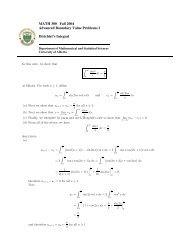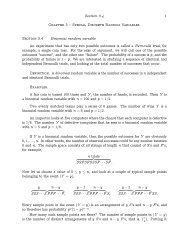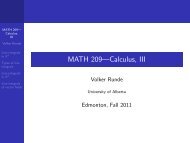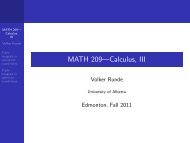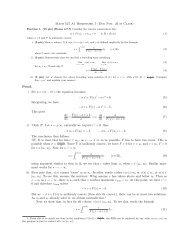Math 411: Honours Complex Variables - University of Alberta
Math 411: Honours Complex Variables - University of Alberta
Math 411: Honours Complex Variables - University of Alberta
You also want an ePaper? Increase the reach of your titles
YUMPU automatically turns print PDFs into web optimized ePapers that Google loves.
four subtriangles, denoted by ∆(z0,z1,z2), ∆(z1,z3,z2), ∆(z1,w,z3), and ∆(z2,z3,z).<br />
As in the pro<strong>of</strong> <strong>of</strong> Goursat’s Lemma, we have<br />
� � � � �<br />
f = f + f + f + f.<br />
∂∆<br />
∂∆(z0,z1,z2)<br />
∂∆(z1,z3,z2)<br />
∂∆(z1,w,z3)<br />
∂∆(z2,z3,z)<br />
Since ∆(z1,z3,z2),∆(z1,w,z3),∆(z2,z3,z) ⊂ D\{z0}, and since f is holomorphic on<br />
D \{z0}, Goursat’s Lemma yields<br />
� � �<br />
f = f = f = 0,<br />
∂∆(z1,z3,z2)<br />
so that �<br />
It follows that<br />
��<br />
�<br />
�<br />
�<br />
∂∆<br />
�<br />
�<br />
f�<br />
� =<br />
��<br />
�<br />
�<br />
�<br />
∂∆(z0,z1,z2)<br />
∂∆<br />
∂∆(z1,w,z3)<br />
�<br />
f =<br />
∂∆(z0,z1,z2)<br />
∂∆(z2,z3,z)<br />
f.<br />
�<br />
�<br />
f�<br />
� ≤ ℓ(∂∆(z0,z1,z2)) sup |f(ζ)|.<br />
ζ∈∂∆(z0,z1,z2)<br />
Since|f|iscontinuouson∆, itisboundedabovebysomeM > 0. Byplacingz1 andz2<br />
sufficiently close to z0, we see that ℓ(∂∆(z0,z1,z2)) can be made smaller than every<br />
ǫ/M > 0. We deduce that �<br />
f = 0. The result then follows from Theorem 5.2.<br />
∂∆<br />
Let z0 ∈ C, and let r > 0. Slightly abusing notation, we use ∂Br(z0) to denote<br />
the boundary <strong>of</strong> Br(z0) oriented counterclockwise.<br />
Lemma 5.2. Let D ⊂ C be open, let z0 ∈ D, and let r > 0 be such that Br[z0] ⊂ D.<br />
Then �<br />
1<br />
dζ = 2πi<br />
ζ −z<br />
for all z ∈ Br(z0).<br />
∂Br(z0)<br />
Pro<strong>of</strong>. Through direct computation, we saw on pg. 24 that<br />
�<br />
1<br />
dζ = 2πi.<br />
ζ −z0<br />
∂Br(z0)<br />
Let z ∈ Br(z0), and choose ǫ > 0 such that Bǫ[z] ⊂ Br(z0), so that<br />
�<br />
1<br />
dζ = 2πi.<br />
ζ −z<br />
We need to show that<br />
� �<br />
1<br />
dζ =<br />
ζ −z<br />
∂Br(z0)<br />
∂Bǫ(z)<br />
∂Bǫ(z)<br />
�<br />
1<br />
dζ = −<br />
ζ −z ∂Bǫ(z) −<br />
1<br />
ζ −z dζ.<br />
33



